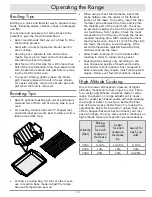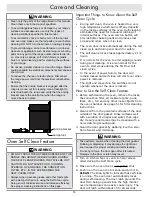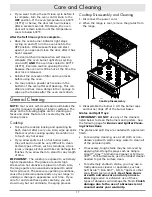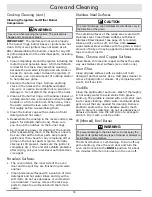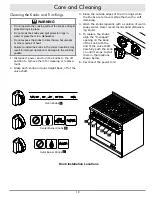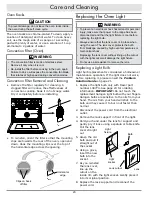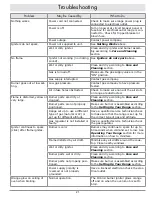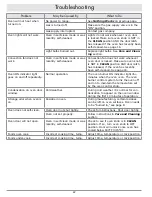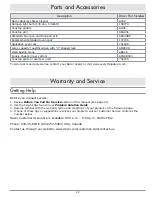
8
Operating the Range
Selecting the Cookware
For overall safety and best performance, select the
correct cooking utensil for the food being cooked.
Improperly selected cooking utensils will not cook
evenly or efficiently.
Use cookware that:
• Has flat, smooth bottoms.
• Is well balanced.
• Has tight fitting lids to keep heat, odors and
steam in.
Cooktop Operation
• To avoid the chance of fire, explosion or carbon monoxide poisoning, do not attempt to use your range without the
burners completely and properly assembled (see page 6). The burner rings must be properly seated for proper
burner lighting and operation.
• To avoid burns and scalding, always turn pan handles to a position where they cannot be easily hit. Also, handles
should not extend over adjacent burners. Always set utensils gently onto the grates and center them so that they are
well-balanced.
• Do not drag cookware across the grates. Sliding may damage the finish. Lift utensils to reposition them. Do not drop
them on the grate.
• Cookware with rough bottoms can cause permanent damage to the coated surfaces on the grates.
• To avoid burns or fire hazard, reduce the flame level
if it extends beyond the bottom of the utensil. A flame
that extends up the sides of the utensil is potentially
dangerous.
• In the interest of safety, always light the burner before
putting the cooking utensil on the grate. Turn the
burner knob to the
OFF
position before removing the
utensil. Always check all the burner knobs to make
sure the range is
OFF
when you are finished cooking.
• Do not turn the knob farther than the
HIGH
position until lit. Doing so may result in a burst of flame that could cause
burns or damage to the surrounding area.
• Do not touch any part of the burner while the igniter is sparking. An electric shock could result.
• Never light the burners with a match or other open flame.
• If the gas does not ignite after four seconds or if the flame goes out and gas escapes, turn the knob to the
OFF
position. Open a window and allow at least five minutes for the gas to dissipate. Repeat the lighting procedure.
WARNING
Burning-in the Oven
When the oven comes from the factory, residue for
certain materials used in the manufacturing process
are left on the parts of the oven. These residues
should be “burned off” before the oven is used for
the first time.
To burn off the residues in the oven:
1. Birds or other small pets may be sensitive to the
odors during first operation. Remove them to
another part of the house and close the door.
IMPORTANT
: Avoid spills as much as possible.
The porcelain surfaces of the grates, spill trays and
burner caps are acid-resistant but not acid-proof.
Some foods can cause permanent damage if allowed
to remain on porcelain surfaces.
2. Open windows and turn on the range hood to
allow the odors and smoke to escape.
3. Turn the oven to the
BROIL
setting for 10 min-
utes. It is normal for odors and smoke to come
out of the vent slot on the backguard during this
process.
4. After ten minutes, turn the oven control knob
down to 350˚F. Leave the oven at 350˚F for 30
minutes.
5. After 30 minutes, turn off the oven. Close the
windows and turn off the range hood when the
odors and smoke finish clearing.

















